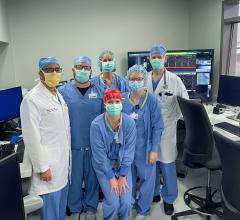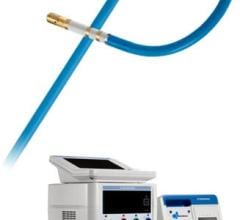
May 25, 2018 — Data from the first-in-human study using pulsed electric field (PEF) energy ablate heart tissue in the treatment atrial fibrillation shows very positive evidence and may usher in a new era of tissue-specific, ultra-rapid ablation. This was according to researchers presenting this late-breaking study at Heart Rhythm 2018, the Heart Rhythm Society’s 39th Annual Scientific Sessions.
Standard thermal energy sources rely on time-dependent conductive heating/cooling, and ablates all tissue types indiscriminately. PEF energy ablates non-thermally by creating microscopic pores in cell membranes, called electroporation. PEF is highly tissue selective since characteristic threshold field strengths induce necrosis in specific tissues and leave other surrounding tissue unharmed.
This is attractive to consider for AF ablation since cardiomyocytes have among the lowest threshold values (400 V/cm) of any tissue, which allows tissue selectivity and minimizing ablation of non-target tissue (including the esophagus, phrenic nerve, etc.). PEF also is fast (energy delivered over just a few seconds), and the absence of coagulative necrosis obviates the risk of pulmonary vein (PV) stenosis.
PEF ablation was performed in two trials using custom systems. The Iowa Approach Inc. system (Figure 1) uses a epicardial linear catheter for PV plus left atrium (LA) encircling to generate a posterior box lesion during concomitant cardiac surgery. The other system used an endocardial over-the-wire catheter for percutaneous transeptal PV isolation. For all cases, endocardial LA-PV voltage maps were created pre- and post-encirclement (using either the Boston Scientific Rhythmia or Biosense Webster Carto electromapping systems).
At two centers, 22 patients were ablated under general anesthesia: A) 7 epicardial patients during valve (6) or CABG (1) surgery - 69±6.4 years, 2F/5M, 6 PAF/1 PerAF, and B) 15 endocardial patients —64±4.6 yrs, 8F/7M, all PAF. Box lesions were successful in 6 out of 7 epicardial patients (86%) using two lesions per patient. The failure was related to equipment malfunction. Including mapping, procedure time for epicardial ablation was 55±21 min.
Catheter PVI was successful in all 57 PVs in 15 patients (100%) using 3.3±0.5 lesions/PV. Procedure time was 67±10 min, catheter time (PEF catheter entry to exit of LA) = 19±2.5 min (range 16 - 23), total PEF energy delivery time < 60 sec/pt, fluoroscopy time = 12±4.0 min. There were no complications.
The researchers said these data may help usher in a new era of tissue-specific, ultra-rapid ablation of atrial fibrillation. They said PEF appears promising for AF ablation, but additional studies are warranted.
Electroporation is discussed as a new technique in the VIDEO Current State of Atrial Fibrillation Ablation Technologies.
Find links to all the Heart Rhythm 2018 late-breaking studies.


 March 27, 2025
March 27, 2025 








